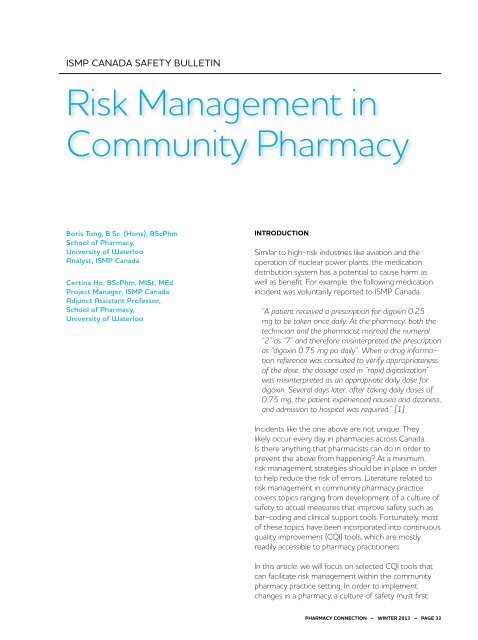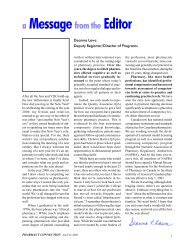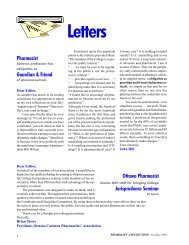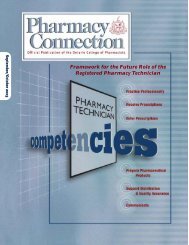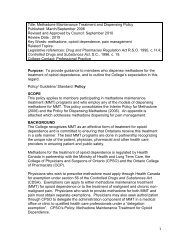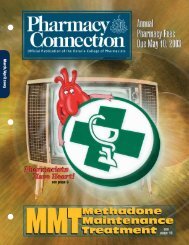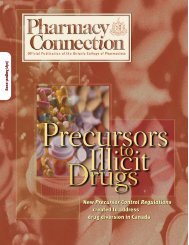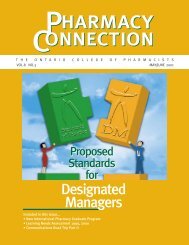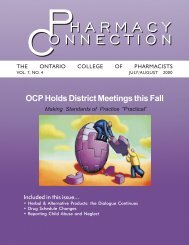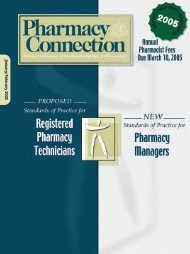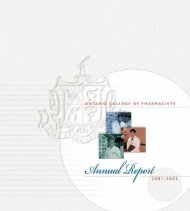Download - Ontario College of Pharmacists
Download - Ontario College of Pharmacists
Download - Ontario College of Pharmacists
You also want an ePaper? Increase the reach of your titles
YUMPU automatically turns print PDFs into web optimized ePapers that Google loves.
ISMP CANADA SAFETY BULLETIN<br />
Risk Management in<br />
Community Pharmacy<br />
Boris Tong, B.Sc. (Hons), BScPhm<br />
School <strong>of</strong> Pharmacy,<br />
University <strong>of</strong> Waterloo<br />
Analyst, ISMP Canada<br />
Certina Ho, BScPhm, MISt, MEd<br />
Project Manager, ISMP Canada<br />
Adjunct Assistant Pr<strong>of</strong>essor,<br />
School <strong>of</strong> Pharmacy,<br />
University <strong>of</strong> Waterloo<br />
Introduction<br />
Similar to high-risk industries like aviation and the<br />
operation <strong>of</strong> nuclear power plants, the medication<br />
distribution system has a potential to cause harm as<br />
well as benefit. For example, the following medication<br />
incident was voluntarily reported to ISMP Canada.<br />
“A patient received a prescription for digoxin 0.25<br />
mg to be taken once daily. At the pharmacy, both the<br />
technician and the pharmacist misread the numeral<br />
“2” as “7” and therefore misinterpreted the prescription<br />
as “digoxin 0.75 mg po daily”. When a drug information<br />
reference was consulted to verify appropriateness<br />
<strong>of</strong> the dose, the dosage used in “rapid digitalization”<br />
was misinterpreted as an appropriate daily dose for<br />
digoxin. Several days later, after taking daily doses <strong>of</strong><br />
0.75 mg, the patient experienced nausea and dizziness,<br />
and admission to hospital was required.” [1]<br />
Incidents like the one above are not unique. They<br />
likely occur every day in pharmacies across Canada.<br />
Is there anything that pharmacists can do in order to<br />
prevent the above from happening? At a minimum,<br />
risk management strategies should be in place in order<br />
to help reduce the risk <strong>of</strong> errors. Literature related to<br />
risk management in community pharmacy practice<br />
covers topics ranging from development <strong>of</strong> a culture <strong>of</strong><br />
safety to actual measures that improve safety such as<br />
bar-coding and clinical support tools. Fortunately, most<br />
<strong>of</strong> these topics have been incorporated into continuous<br />
quality improvement (CQI) tools, which are mostly<br />
readily accessible to pharmacy practitioners.<br />
In this article, we will focus on selected CQI tools that<br />
can facilitate risk management within the community<br />
pharmacy practice setting. In order to implement<br />
changes in a pharmacy, a culture <strong>of</strong> safety must first<br />
PHARMACY CONNECTION ~ WINTER 2013 ~ PAGE 33


